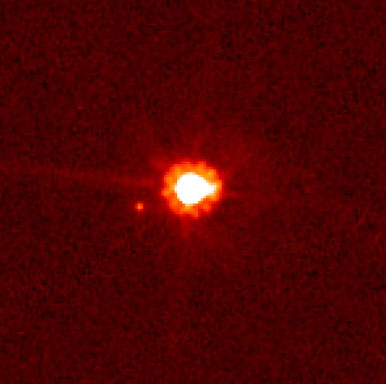 This is a Hubble Space Telescope image of the 9th largest known object in our solar system (besides the sun), and its moon.
This is a Hubble Space Telescope image of the 9th largest known object in our solar system (besides the sun), and its moon.
Pluto, right?
…
Pluto, wrong.
It’s Eris, the largest dwarf planet, and Dysnomia, its moon.
I tell visitors that this is one of the reasons that “dwarf planets” as a new classification of planets was introduced–there are objects in our solar system that are bigger than Pluto. Should that make them a planet?
Here’s a typical exchange that occurs when someone brings up Pluto/Dwarf Planets:
Me: Is Pluto a planet?
School Kids: No!
Me: What makes something a planet?
School Kids: It’s made of dirt!
Me: Ok, dirt– like it has a ground you can stand on. But how about Jupiter, and the rest of the outer planets? Do they have a ground?
School Kids: No?
Me: That’s right, they don’t. They’re made of gas, that’s why they’re called “gas giants.” So a planet doesn’t need ground. If not, what exactly makes something a planet?
School Kids: It has to be round!
Me: Round like a circle?
School Kids: No, round like a ball, smart arse.
Me: Ah, then we call that “spherical.” Ok, well, the Sun is spherical. Does that make it a planet?
School Kids: Of course not, don’t be silly.
Me: So what makes something a planet?
School Kids: It has to orbit the Sun.
Me: But asteroids and comets orbit the sun, does that make them planets?
School Kids: No, it has to orbit the sun and be big.
Me: Bigger than Pluto.
School Kids: Yes, jeez!
Me: So our moon is a planet then, because it’s bigger than Pluto and orbits the sun. Right?
School Kids: Uh… No?
Me: You’re right, the Moon is a moon, a satellite. And it’s good that’s not the deciding factor, because there are seven moons in our solar system that are larger than Pluto: Ganymede, Titan, Callisto, Io, the Moon, Europa, and Triton. So if they’re not planets, then what makes something a planet?
School Kids: Uh… Just where are you going with this, wise guy?
Me: There are a handful of technical definitions for what makes something a planet or not, but to be perfectly honest, the only way to know for sure if something is a planet or not–a bunch of people get together and vote.
School Kids: Say what now?
Me: It’s true, the International Astronomical Union governs the naming conventions for astronomical bodies.
School Kids: So some dudes get to decide if something’s a planet or not?
Me: Dudes and ladies. Pretty much, yeah.
School Kids: Far out, man.
Me: Word.
Ok, maybe that’s not verbatim, but fairly you get the idea.
Ultimately, the confusion surrounding the classifications of these things (dwarf planets, plutoids, TNOs, etc.) is just semantics: the words describing them don’t actually change what they are: small objects in the outer edges of the solar system.
Anyway, I digress. A trio of astronomers scouring the sky for Trans-Neptunian Objects found Eris on January 5 of 2005, after studying photos taken in 2003. (The sky is a big place to observe; often discoveries are made long after initial images are taken, because there’s just so much darn data to look at.)
The namesake of this dwarf planet is the Roman goddess of strife and discord, an appropriate association since Eris was one of the reasons the IAU decided to start thinking about new solar system classifications, an act that has led to a considerable strife and discord over the demotion of Pluto.
Astronomers love relating names like this, and Dysnomia is another perfect example. Follow this train of geek-thought:
Eris was informally nicknamed Xena by the discovery team, and naturally Xena’s moon should be Gabrielle. The meaning of “dysnomia” translates to “lawlessness” in English–And the character of Xena was played by actress Lucy Lawless.
And yes, that was totally on purpose.
I did make the mistake (once) of trying to explain this connection to a school group of 3rd graders in my theater. Of course the teachers knew who I was talking about, but the kids had no clue.
I was half tempted to say, “You know, that amazonian lesbian couple from the syndicated psuedo-Roman TV show in the mid-90s…” but fortunately kept my mouth shut.
